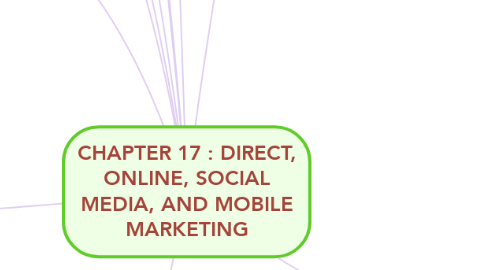
1. Example: Lazada.com interact directly with customers via its websites and mobile apps.
2. Direct & Digital Marketing
2.1. involve engaging directly with carefully targeted individuals consumers and customers communities to both an immediate response and build lasting customers relationship.
2.2. RAPID GROWTH OF DIRECT & DIGITAL MARKETING :
2.2.1. Direct and Digital Marketing have become the fastest-growing form of marketing.
3. Benefits Of Direct & Digital Marketing to Buyers
3.1. Convenience
3.2. Buyers or customers can make purchases from their home or office just using website from online or mobile apps for buy the product or service.
3.3. No sales people
3.4. Shoppers don’t enjoy dealing with sales people because they prefer using direct marketing without face to face to interact with them.
3.5. Special offers
3.6. Buyers may have access to special offers that are only available through direct marketing.
4. Benefits of Direct & Digital Marketing to Sellers
4.1. Provides low-cost and efficient
4.2. Direct marketing often provides a low cost, efficient, speedy alternative for reaching their markets.
4.3. Offers seller greater flexibility
4.4. The marketers make ongoing adjustments to price and programs, or create immediate, timely and personal engagement and offers.
5. FORMS OF DIRECT AND DIGITAL MARKETING
5.1. Digital and social media marketng
5.2. Online marketing(websites,online advertising, email, online videos,blogs),social media marketing, mobile marketing
6. MARKETING, THE INTERNET,AND THE DIGITAL AGE
6.1. Omni-channel retailing creates a seamless cross-channel buying experience that integrates in-store, online, and mobile shopping—creates a single shopping experience
7. DIGITAL AND SOCIAL MEDIA MARKETING
7.1. Using digital marketing tools such as websites, social media, mobile apps and ads, online video, email, and blogs that engage consumers anywhere, anytime via their digital devices
8. Online Marketing
8.1. Online marketing
8.2. marketing via the Internet using company Web sites, online ads and promotions, e-mail, online video, and blogs.
8.3. Marketing Web sites
8.4. engage consumers to move them closer to a direct purchase or other marketing outcome. exp: GEICO
8.5. Branded community Web sites
8.6. present brand content that engages consumers and creates customer community around a brand. exp: ESPN
8.7. Online advertising
8.8. advertising that appears while consumers are browsing online and includes display ads, search-related ads, online classifieds, and other forms.
8.9. E-mail marketing
8.10. involves sending highly targeted, highly personalized, relationship-building marketing messages via e-mail.
8.11. Spam
8.12. unsolicited, unwanted commercial e-mail messages.
9. Social Media Marketing Advantages And Challenges
9.1. Targeted and Personal
9.2. Cost effective
9.3. Immediate and timely
9.4. Engagement and social sharing capabilities
9.5. Mobile Marketing
9.5.1. Mobile marketing is a multi-channel, digital marketing strategy aimed at reaching a target audience on their smartphones, tablets or other mobile devices via websites, email, SMS and MMS, and apps.
10. TRADITIONAL DIRECT MARKETING FORM
10.1. DIRECT-MAIL MARKETING
10.1.1. Occurs by sending an offer, announcement, reminder or other item directly.
10.1.2. Type Of Direct-Mail Marketing
10.1.3. Catalogues
10.1.4. Postcard
10.1.5. Self-Mailers
10.1.6. Dimensional Mail
10.1.7. Advantage
10.1.8. Communicate one to one with target audience.
10.1.9. Allow to control who receive the message.
10.1.10. Effective at getting response.
10.2. CATALOG MARKETING
10.2.1. Through print, video, or digital catalogs that are mailed to select customers made available in stores or presented online.
10.2.2. Type Of Catalog Marketing
10.2.3. Online catalog
10.2.4. Print catalog
10.3. TELEMARKETING
10.3.1. Process of selling product or services over the telephone
10.3.2. Telemarketing Activities
10.3.3. Outbound
10.3.4. Inbound
10.4. DIRECT-RESPONSE TELEVISION MARKETING
10.4.1. Refer to any television commercial which prompts viewers to contact the company directly
10.4.2. 2 Major Forms
10.4.3. Direct-Response Television Advertising
10.4.4. Interactive Television (iTV) Advertising
10.5. KIOSK MARKETING
10.5.1. A small stand alone units that performs a specific function, generally without management intervention.
10.5.2. Advantaget of Kiosk Marketing
10.5.3. Multiple Location
10.5.4. Flexible hour of operation
10.5.5. Easy maintenance
11. PUBLIC POLICY ISSUES IN DIRECT AND DIGITAL MARKETING
11.1. PUBLIC POLICY
11.1.1. As a system of laws regulatory measures, courses of action and funding priorities concerning a given topic promulagated by a governmental entity or its representatives.- A major aspect of public policy is law.
11.1.2. IRRITATION
11.1.2.1. Includes annoying and offending customers
11.1.3. UNFAIRNESS
11.1.3.1. Includes taking unfair advantage of impulse or less
11.1.3.2. -sophisticated buyers
11.1.4. DECEPTION
11.1.4.1. Includes ‘heat merchants’ who design mailers and writer copy designed to mislead consumers.
11.1.5. FRAUD
11.1.5.1. Includes identity theft and financial scams
11.2. CONSUMER PRIVACY
11.2.1. Involves concern that marketers may have too much information and use it to take unfair advantage. Protection is the use of laws and regulations to protect individuals from privacy loss due to the failures and limitations of corporate customer privacy measures.
11.2.2. The Personal Data Protection Act 2010 (PDPA) protects personal data from being misused.
11.2.3. Personal data is defined as any information collected or processed in connection to commercial transaction by any equipment operating automatically (eg, ATM, computer) which is capable of identifying a person.
11.2.4. The Act will imposes a duty on data users to put in place adequate the theft, misuse, unauthorized acces, accidental disclosure, alteration or destruction of data under their care. The Act also provides for the rights of data subjects access, modify and update their personal data.
11.3. A NEED FOR ACTION
11.3.1. AdChoices
11.3.2. Can Spam
11.3.3. Children’s Online Privacy Protection Act (COPPA)
11.3.4. TRUSTe
